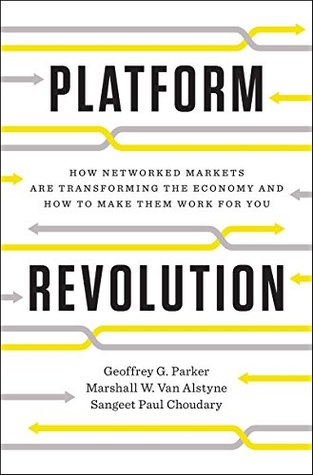More on this book
Community
Kindle Notes & Highlights
Started reading
October 6, 2019
The total purchase price for the three companies: a hefty $710 million. “What’s really astounding,” one analyst commented, “is that none of the companies acquired make actual devices. Instead, everything is about platform and data.
And—more importantly—users.”
In combination, the three acquisitions boast 130 milli...
This highlight has been truncated due to consecutive passage length restrictions.
Like Nike, Under Armour sees that the future of its industry is platform-based, and it is de...
This highlight has been truncated due to consecutive passage length restrictions.
Industrial giants including GE, Siemens, and Haier are connecting their machines to the na...
This highlight has been truncated due to consecutive passage length restrictions.
Can any product or service become the basis of a platform business? Here’s the test: if the firm can use either information or community to add value to what it sells, then there is potential for creating a viable platform.
Wolfe reached out to Barry Wacksman, a partner at R/GA, a leading New York design firm that had helped Nike design its platform.
So platforms are eating the world.
Along the way, however, they unlocked a much more promising business prospect. Back in October
Large enterprises do have some advantages when launching platform businesses. They have existing value chains, powerful alliances and partnerships with other companies, pools of talent to draw upon, and vast arsenals of resources—including loyal customer bases.
business opportunity, don’t be intimidated by the prospect of a giant competitor encroaching on your space. The rules of the growth game have changed, and if you understand and master the new rules, you have as good a chance of surviving and thriving as anyone.
Consider Amazon. It never faced the chicken-or-egg problem because, as a successful online retailer, it operated an effective pipeline business that used online product listings to attract consumers. With a thriving consumer base, Amazon converted itself into a platform business simply by opening its system to external producers.
The single-side strategy. Create a business around products or services that benefit a single set of users; later, convert the business into a platform business by attracting a second set of users who want to engage in interactions with the first set.
The producer evangelism strategy: Design your platform to attract producers, who can induce their customers to become users of the platform.
They sign up influential teachers,
The big-bang adoption strategy. Use one or more traditional push marketing strategies
Twitter had launched nine months earlier, but wasn’t getting heavy adoption. Jack Dorsey
Twitter received the festival’s Web Award for the year’s best online innovation, and by the end of SXSW, Twitter usage had tripled, from 20,000 tweets per day to 60,000.
Users won’t readily move to a new social network unless it offers something remarkably different.
the sender, the value unit, the external network, and the recipient. Let’s consider the viral growth of Instagram:
What is less well known is that Instagram achieved this rapid growth without employing a single traditional marketing manager.
Airbnb encouraged users with rooms to rent (hosts) to list their offerings (value units) on Craigslist (external network).
Most well-designed platforms create far more value than they directly capture—which is why they attract large numbers of users, who are happy to enjoy the benefits of all the “free” value provided by the platform.
A smart monetization strategy begins by considering all four forms of value, then determines which sources of excess value can be exploited by the platform without inhibiting the continued
(2): CHARGING FOR ACCESS In some cases, it’s possible to monetize a platform by charging producers for access to a community of users who have
strategy for Haier Group, a Chinese manufacturing company, “You never take first money.” In other words, only after a value unit has been created and exchanged with results that are satisfactory to both the producer and the consumer should the platform business itself seek to capture a share of that value. A number of highly promising platforms have foundered because they ignored this rule and instead rushed to monetize their offerings prematurely. Sean Percival, the former vice president of online marketing for the failed social network
value. The greater the number of positive interactions the platform
But to fully understand how the rise of the platform is transforming the nature of competition, we need to reexamine the traditional concepts of competition that have dominated business thinking for decades—and that many businesspeople still take for granted.
Porter’s model identifies five forces that affect the strategic position of a particular business: the threat of new entrants to the market, the threat of substitute products or services, the bargaining power of customers, the bargaining power of suppliers, and the intensity of competitive rivalry in the industry.


